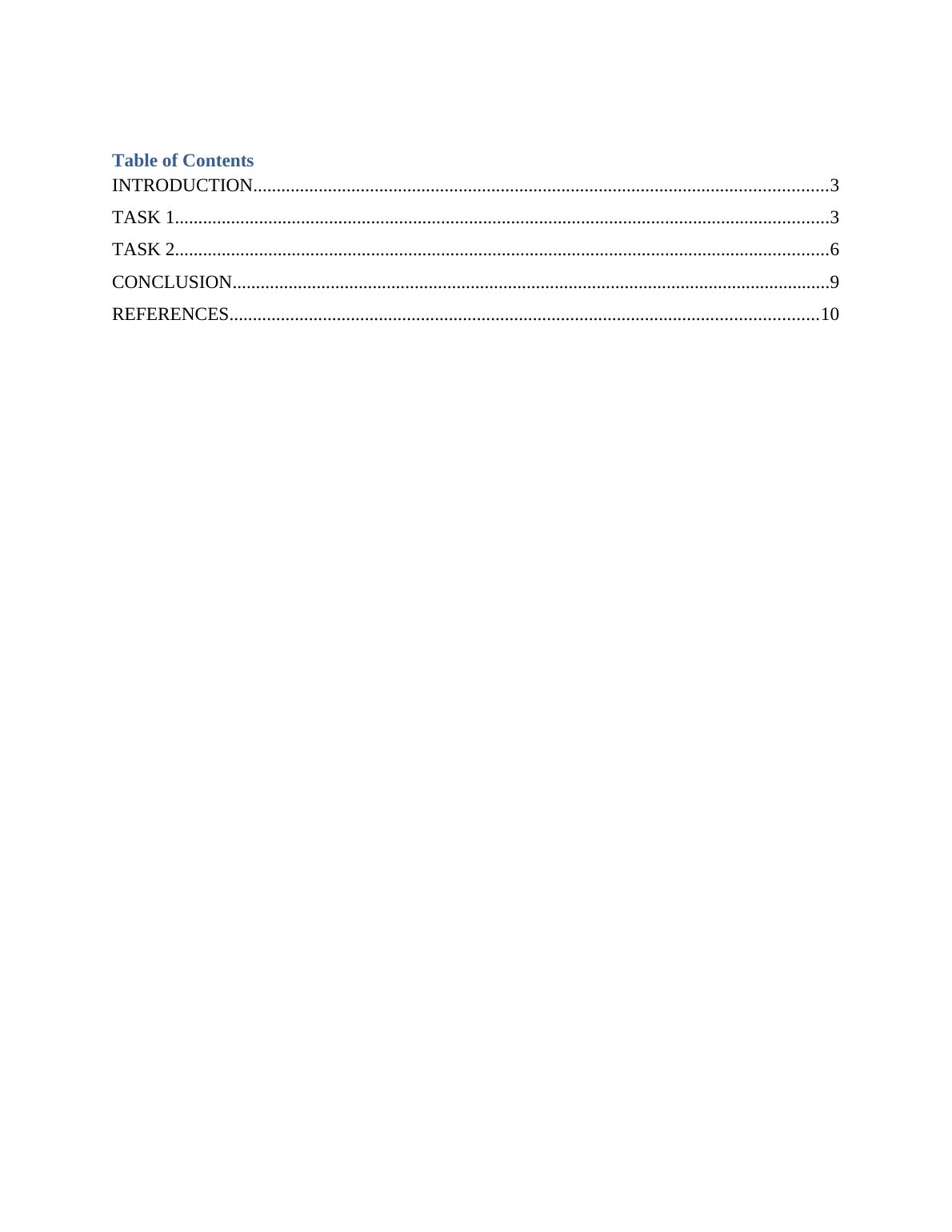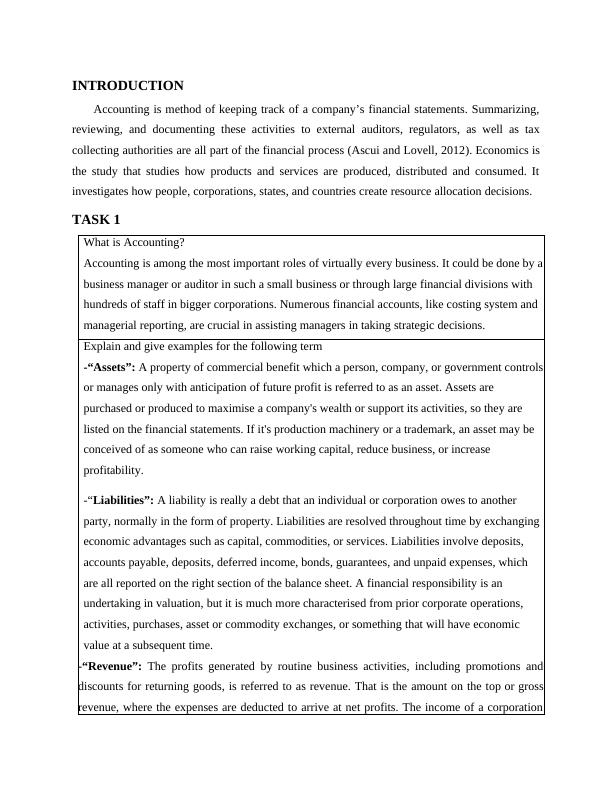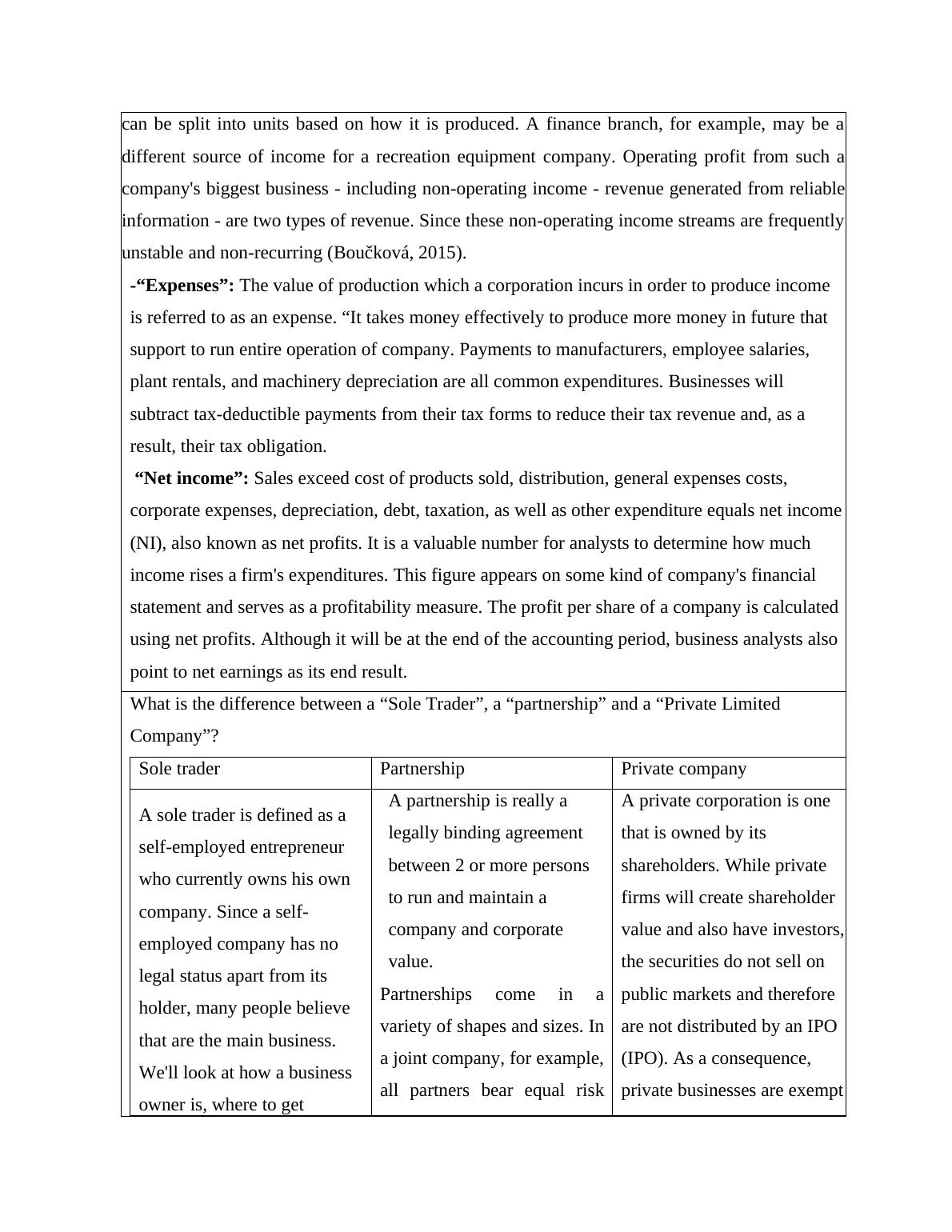Introduction to Economics and Accounting
Added on 2022-12-27
11 Pages2441 Words69 Views
Introduction to
Economics and
Accounting
Economics and
Accounting

Table of Contents
INTRODUCTION...........................................................................................................................3
TASK 1............................................................................................................................................3
TASK 2............................................................................................................................................6
CONCLUSION................................................................................................................................9
REFERENCES..............................................................................................................................10
INTRODUCTION...........................................................................................................................3
TASK 1............................................................................................................................................3
TASK 2............................................................................................................................................6
CONCLUSION................................................................................................................................9
REFERENCES..............................................................................................................................10

INTRODUCTION
Accounting is method of keeping track of a company’s financial statements. Summarizing,
reviewing, and documenting these activities to external auditors, regulators, as well as tax
collecting authorities are all part of the financial process (Ascui and Lovell, 2012). Economics is
the study that studies how products and services are produced, distributed and consumed. It
investigates how people, corporations, states, and countries create resource allocation decisions.
TASK 1
What is Accounting?
Accounting is among the most important roles of virtually every business. It could be done by a
business manager or auditor in such a small business or through large financial divisions with
hundreds of staff in bigger corporations. Numerous financial accounts, like costing system and
managerial reporting, are crucial in assisting managers in taking strategic decisions.
Explain and give examples for the following term
-“Assets”: A property of commercial benefit which a person, company, or government controls
or manages only with anticipation of future profit is referred to as an asset. Assets are
purchased or produced to maximise a company's wealth or support its activities, so they are
listed on the financial statements. If it's production machinery or a trademark, an asset may be
conceived of as someone who can raise working capital, reduce business, or increase
profitability.
-“Liabilities”: A liability is really a debt that an individual or corporation owes to another
party, normally in the form of property. Liabilities are resolved throughout time by exchanging
economic advantages such as capital, commodities, or services. Liabilities involve deposits,
accounts payable, deposits, deferred income, bonds, guarantees, and unpaid expenses, which
are all reported on the right section of the balance sheet. A financial responsibility is an
undertaking in valuation, but it is much more characterised from prior corporate operations,
activities, purchases, asset or commodity exchanges, or something that will have economic
value at a subsequent time.
-“Revenue”: The profits generated by routine business activities, including promotions and
discounts for returning goods, is referred to as revenue. That is the amount on the top or gross
revenue, where the expenses are deducted to arrive at net profits. The income of a corporation
Accounting is method of keeping track of a company’s financial statements. Summarizing,
reviewing, and documenting these activities to external auditors, regulators, as well as tax
collecting authorities are all part of the financial process (Ascui and Lovell, 2012). Economics is
the study that studies how products and services are produced, distributed and consumed. It
investigates how people, corporations, states, and countries create resource allocation decisions.
TASK 1
What is Accounting?
Accounting is among the most important roles of virtually every business. It could be done by a
business manager or auditor in such a small business or through large financial divisions with
hundreds of staff in bigger corporations. Numerous financial accounts, like costing system and
managerial reporting, are crucial in assisting managers in taking strategic decisions.
Explain and give examples for the following term
-“Assets”: A property of commercial benefit which a person, company, or government controls
or manages only with anticipation of future profit is referred to as an asset. Assets are
purchased or produced to maximise a company's wealth or support its activities, so they are
listed on the financial statements. If it's production machinery or a trademark, an asset may be
conceived of as someone who can raise working capital, reduce business, or increase
profitability.
-“Liabilities”: A liability is really a debt that an individual or corporation owes to another
party, normally in the form of property. Liabilities are resolved throughout time by exchanging
economic advantages such as capital, commodities, or services. Liabilities involve deposits,
accounts payable, deposits, deferred income, bonds, guarantees, and unpaid expenses, which
are all reported on the right section of the balance sheet. A financial responsibility is an
undertaking in valuation, but it is much more characterised from prior corporate operations,
activities, purchases, asset or commodity exchanges, or something that will have economic
value at a subsequent time.
-“Revenue”: The profits generated by routine business activities, including promotions and
discounts for returning goods, is referred to as revenue. That is the amount on the top or gross
revenue, where the expenses are deducted to arrive at net profits. The income of a corporation

can be split into units based on how it is produced. A finance branch, for example, may be a
different source of income for a recreation equipment company. Operating profit from such a
company's biggest business - including non-operating income - revenue generated from reliable
information - are two types of revenue. Since these non-operating income streams are frequently
unstable and non-recurring (Boučková, 2015).
-“Expenses”: The value of production which a corporation incurs in order to produce income
is referred to as an expense. “It takes money effectively to produce more money in future that
support to run entire operation of company. Payments to manufacturers, employee salaries,
plant rentals, and machinery depreciation are all common expenditures. Businesses will
subtract tax-deductible payments from their tax forms to reduce their tax revenue and, as a
result, their tax obligation.
“Net income”: Sales exceed cost of products sold, distribution, general expenses costs,
corporate expenses, depreciation, debt, taxation, as well as other expenditure equals net income
(NI), also known as net profits. It is a valuable number for analysts to determine how much
income rises a firm's expenditures. This figure appears on some kind of company's financial
statement and serves as a profitability measure. The profit per share of a company is calculated
using net profits. Although it will be at the end of the accounting period, business analysts also
point to net earnings as its end result.
What is the difference between a “Sole Trader”, a “partnership” and a “Private Limited
Company”?
Sole trader Partnership Private company
A sole trader is defined as a
self-employed entrepreneur
who currently owns his own
company. Since a self-
employed company has no
legal status apart from its
holder, many people believe
that are the main business.
We'll look at how a business
owner is, where to get
A partnership is really a
legally binding agreement
between 2 or more persons
to run and maintain a
company and corporate
value.
Partnerships come in a
variety of shapes and sizes. In
a joint company, for example,
all partners bear equal risk
A private corporation is one
that is owned by its
shareholders. While private
firms will create shareholder
value and also have investors,
the securities do not sell on
public markets and therefore
are not distributed by an IPO
(IPO). As a consequence,
private businesses are exempt
different source of income for a recreation equipment company. Operating profit from such a
company's biggest business - including non-operating income - revenue generated from reliable
information - are two types of revenue. Since these non-operating income streams are frequently
unstable and non-recurring (Boučková, 2015).
-“Expenses”: The value of production which a corporation incurs in order to produce income
is referred to as an expense. “It takes money effectively to produce more money in future that
support to run entire operation of company. Payments to manufacturers, employee salaries,
plant rentals, and machinery depreciation are all common expenditures. Businesses will
subtract tax-deductible payments from their tax forms to reduce their tax revenue and, as a
result, their tax obligation.
“Net income”: Sales exceed cost of products sold, distribution, general expenses costs,
corporate expenses, depreciation, debt, taxation, as well as other expenditure equals net income
(NI), also known as net profits. It is a valuable number for analysts to determine how much
income rises a firm's expenditures. This figure appears on some kind of company's financial
statement and serves as a profitability measure. The profit per share of a company is calculated
using net profits. Although it will be at the end of the accounting period, business analysts also
point to net earnings as its end result.
What is the difference between a “Sole Trader”, a “partnership” and a “Private Limited
Company”?
Sole trader Partnership Private company
A sole trader is defined as a
self-employed entrepreneur
who currently owns his own
company. Since a self-
employed company has no
legal status apart from its
holder, many people believe
that are the main business.
We'll look at how a business
owner is, where to get
A partnership is really a
legally binding agreement
between 2 or more persons
to run and maintain a
company and corporate
value.
Partnerships come in a
variety of shapes and sizes. In
a joint company, for example,
all partners bear equal risk
A private corporation is one
that is owned by its
shareholders. While private
firms will create shareholder
value and also have investors,
the securities do not sell on
public markets and therefore
are not distributed by an IPO
(IPO). As a consequence,
private businesses are exempt

End of preview
Want to access all the pages? Upload your documents or become a member.
Related Documents
Annual Report Analysislg...
|26
|4645
|486
A cumulative translation adjustmentlg...
|5
|664
|143
Assignment on Taxation- Tax system in UKlg...
|20
|4991
|140
Comprehensive Income 7 Items Included in Other Comprehensive Income 7 Understanding of Items shown under Comprehensive Income 7lg...
|13
|2813
|495
Analysis of Financial Statements of BHP Billitonlg...
|7
|2522
|244
Taxation Law Assignment Samplelg...
|5
|516
|308
